Kai Zhen
Indiana University Bloomington, Alexa Machine Learning, Amazon, USA
Saten: Sparse Augmented Tensor Networks for Post-Training Compression of Large Language Models
May 20, 2025Abstract:The efficient implementation of large language models (LLMs) is crucial for deployment on resource-constrained devices. Low-rank tensor compression techniques, such as tensor-train (TT) networks, have been widely studied for over-parameterized neural networks. However, their applications to compress pre-trained large language models (LLMs) for downstream tasks (post-training) remains challenging due to the high-rank nature of pre-trained LLMs and the lack of access to pretraining data. In this study, we investigate low-rank tensorized LLMs during fine-tuning and propose sparse augmented tensor networks (Saten) to enhance their performance. The proposed Saten framework enables full model compression. Experimental results demonstrate that Saten enhances both accuracy and compression efficiency in tensorized language models, achieving state-of-the-art performance.
Wanda++: Pruning Large Language Models via Regional Gradients
Mar 06, 2025Abstract:Large Language Models (LLMs) pruning seeks to remove unimportant weights for inference speedup with minimal performance impact. However, existing methods often suffer from performance loss without full-model sparsity-aware fine-tuning. This paper presents Wanda++, a novel pruning framework that outperforms the state-of-the-art methods by utilizing decoder-block-level \textbf{regional} gradients. Specifically, Wanda++ improves the pruning score with regional gradients for the first time and proposes an efficient regional optimization method to minimize pruning-induced output discrepancies between the dense and sparse decoder output. Notably, Wanda++ improves perplexity by up to 32\% over Wanda in the language modeling task and generalizes effectively to downstream tasks. Further experiments indicate our proposed method is orthogonal to sparsity-aware fine-tuning, where Wanda++ can be combined with LoRA fine-tuning to achieve a similar perplexity improvement as the Wanda method. The proposed method is lightweight, pruning a 7B LLaMA model in under 10 minutes on a single NVIDIA H100 GPU.
MaZO: Masked Zeroth-Order Optimization for Multi-Task Fine-Tuning of Large Language Models
Feb 17, 2025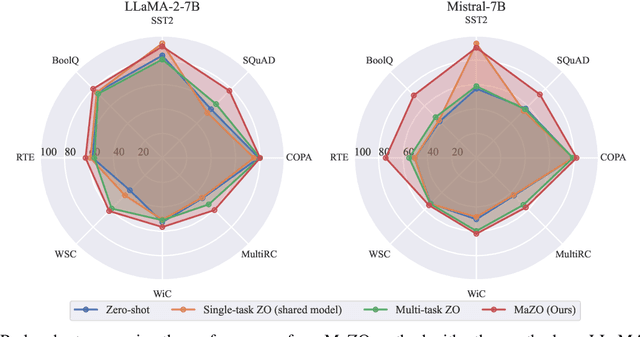
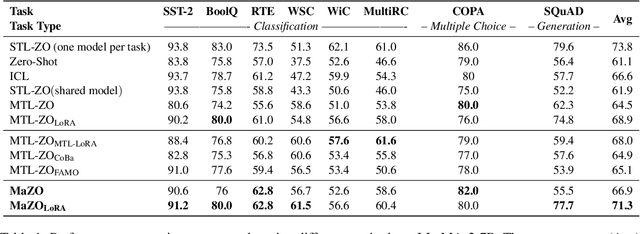


Abstract:Large language models have demonstrated exceptional capabilities across diverse tasks, but their fine-tuning demands significant memory, posing challenges for resource-constrained environments. Zeroth-order (ZO) optimization provides a memory-efficient alternative by eliminating the need for backpropagation. However, ZO optimization suffers from high gradient variance, and prior research has largely focused on single-task learning, leaving its application to multi-task learning unexplored. Multi-task learning is crucial for leveraging shared knowledge across tasks to improve generalization, yet it introduces unique challenges under ZO settings, such as amplified gradient variance and collinearity. In this paper, we present MaZO, the first framework specifically designed for multi-task LLM fine-tuning under ZO optimization. MaZO tackles these challenges at the parameter level through two key innovations: a weight importance metric to identify critical parameters and a multi-task weight update mask to selectively update these parameters, reducing the dimensionality of the parameter space and mitigating task conflicts. Experiments demonstrate that MaZO achieves state-of-the-art performance, surpassing even multi-task learning methods designed for first-order optimization.
QuZO: Quantized Zeroth-Order Fine-Tuning for Large Language Models
Feb 17, 2025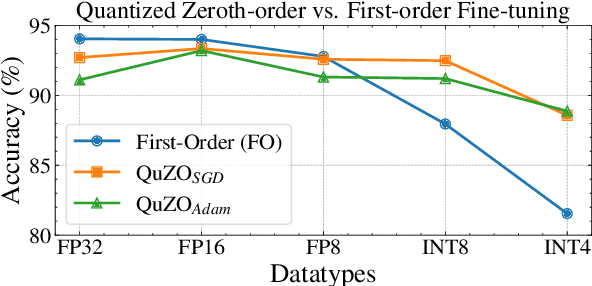
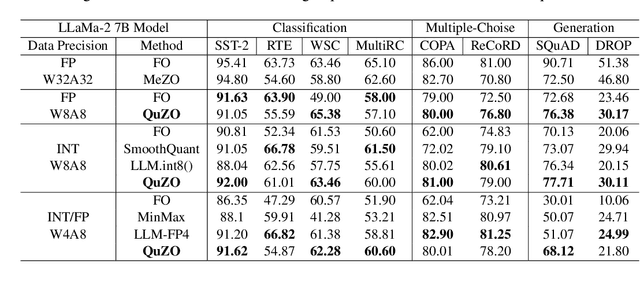


Abstract:Language Models (LLMs) are often quantized to lower precision to reduce the memory cost and latency in inference. However, quantization often degrades model performance, thus fine-tuning is required for various down-stream tasks. Traditional fine-tuning methods such as stochastic gradient descent and Adam optimization require backpropagation, which are error-prone in the low-precision settings. To overcome these limitations, we propose the Quantized Zeroth-Order (QuZO) framework, specifically designed for fine-tuning LLMs through low-precision (e.g., 4- or 8-bit) forward passes. Our method can avoid the error-prone low-precision straight-through estimator, and utilizes optimized stochastic rounding to mitigate the increased bias. QuZO simplifies the training process, while achieving results comparable to first-order methods in ${\rm FP}8$ and superior accuracy in ${\rm INT}8$ and ${\rm INT}4$ training. Experiments demonstrate that low-bit training QuZO achieves performance comparable to MeZO optimization on GLUE, Multi-Choice, and Generation tasks, while reducing memory cost by $2.94 \times$ in LLaMA2-7B fine-tuning compared to quantized first-order methods.
AdaZeta: Adaptive Zeroth-Order Tensor-Train Adaption for Memory-Efficient Large Language Models Fine-Tuning
Jun 26, 2024



Abstract:Fine-tuning large language models (LLMs) has achieved remarkable performance across various natural language processing tasks, yet it demands more and more memory as model sizes keep growing. To address this issue, the recently proposed Memory-efficient Zeroth-order (MeZO) methods attempt to fine-tune LLMs using only forward passes, thereby avoiding the need for a backpropagation graph. However, significant performance drops and a high risk of divergence have limited their widespread adoption. In this paper, we propose the Adaptive Zeroth-order Tensor-Train Adaption (AdaZeta) framework, specifically designed to improve the performance and convergence of the ZO methods. To enhance dimension-dependent ZO estimation accuracy, we introduce a fast-forward, low-parameter tensorized adapter. To tackle the frequently observed divergence issue in large-scale ZO fine-tuning tasks, we propose an adaptive query number schedule that guarantees convergence. Detailed theoretical analysis and extensive experimental results on Roberta-Large and Llama-2-7B models substantiate the efficacy of our AdaZeta framework in terms of accuracy, memory efficiency, and convergence speed.
Sub-8-bit quantization for on-device speech recognition: a regularization-free approach
Oct 17, 2022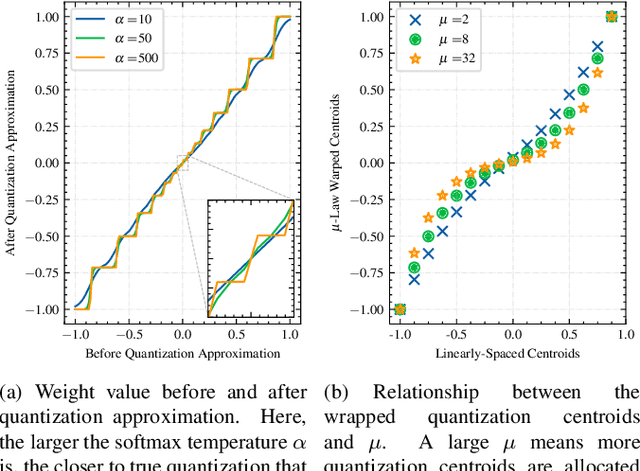
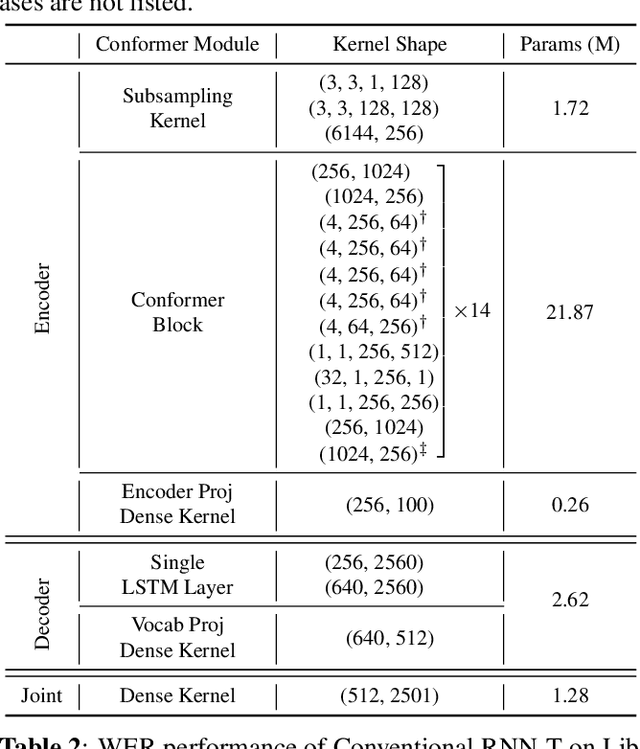

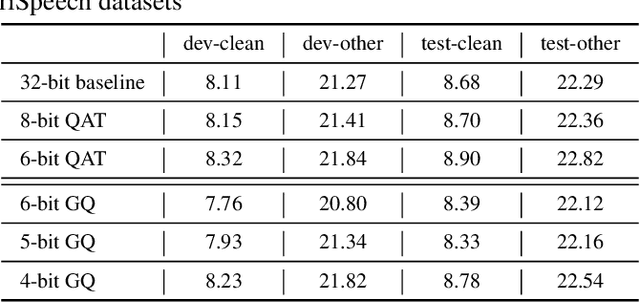
Abstract:For on-device automatic speech recognition (ASR), quantization aware training (QAT) is ubiquitous to achieve the trade-off between model predictive performance and efficiency. Among existing QAT methods, one major drawback is that the quantization centroids have to be predetermined and fixed. To overcome this limitation, we introduce a regularization-free, "soft-to-hard" compression mechanism with self-adjustable centroids in a mu-Law constrained space, resulting in a simpler yet more versatile quantization scheme, called General Quantizer (GQ). We apply GQ to ASR tasks using Recurrent Neural Network Transducer (RNN-T) and Conformer architectures on both LibriSpeech and de-identified far-field datasets. Without accuracy degradation, GQ can compress both RNN-T and Conformer into sub-8-bit, and for some RNN-T layers, to 1-bit for fast and accurate inference. We observe a 30.73% memory footprint saving and 31.75% user-perceived latency reduction compared to 8-bit QAT via physical device benchmarking.
Sub-8-Bit Quantization Aware Training for 8-Bit Neural Network Accelerator with On-Device Speech Recognition
Jun 30, 2022
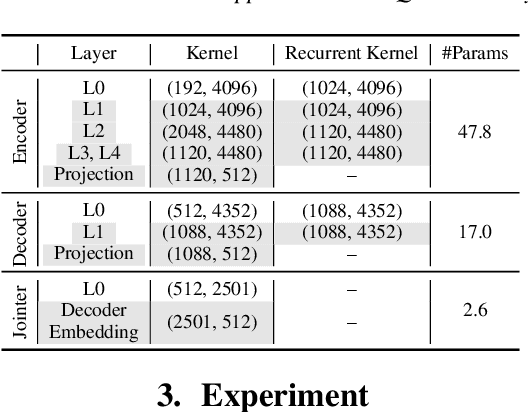
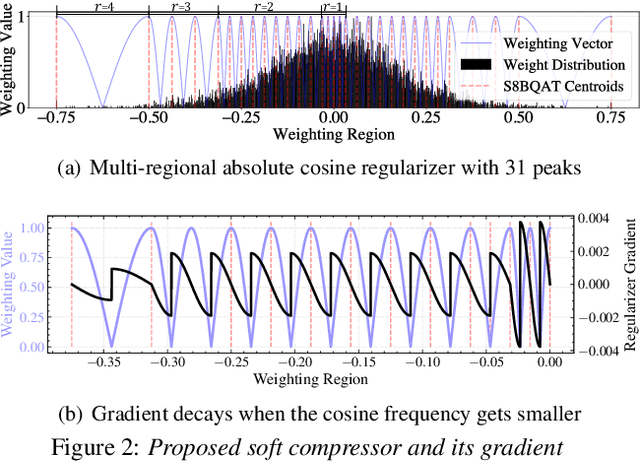
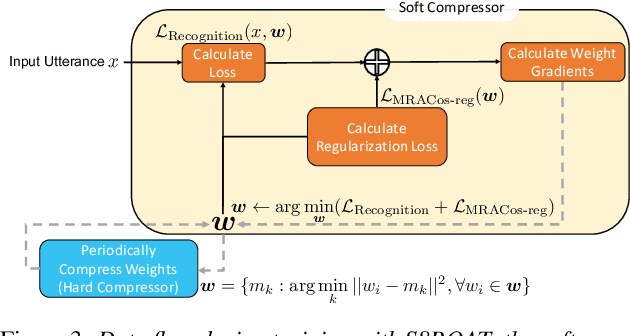
Abstract:We present a novel sub-8-bit quantization-aware training (S8BQAT) scheme for 8-bit neural network accelerators. Our method is inspired from Lloyd-Max compression theory with practical adaptations for a feasible computational overhead during training. With the quantization centroids derived from a 32-bit baseline, we augment training loss with a Multi-Regional Absolute Cosine (MRACos) regularizer that aggregates weights towards their nearest centroid, effectively acting as a pseudo compressor. Additionally, a periodically invoked hard compressor is introduced to improve the convergence rate by emulating runtime model weight quantization. We apply S8BQAT on speech recognition tasks using Recurrent Neural NetworkTransducer (RNN-T) architecture. With S8BQAT, we are able to increase the model parameter size to reduce the word error rate by 4-16% relatively, while still improving latency by 5%.
Scalable and Efficient Neural Speech Coding
Mar 27, 2021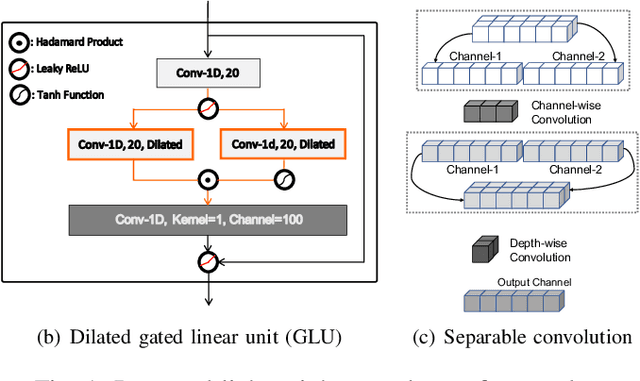
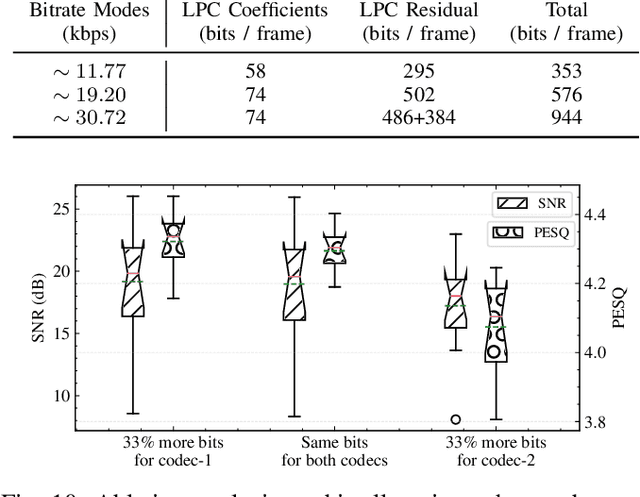

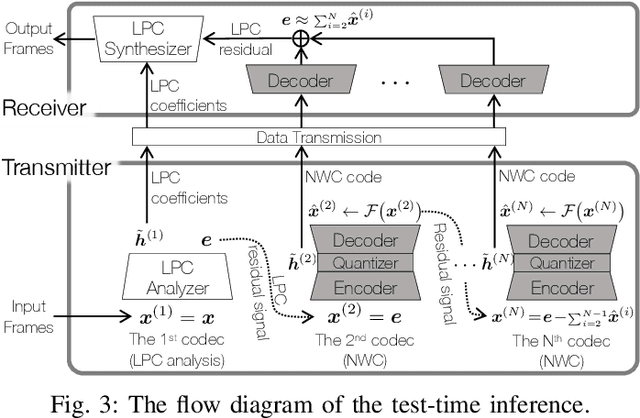
Abstract:This work presents a scalable and efficient neural waveform codec (NWC) for speech compression. We formulate the speech coding problem as an autoencoding task, where a convolutional neural network (CNN) performs encoding and decoding as its feedforward routine. The proposed CNN autoencoder also defines quantization and entropy coding as a trainable module, so the coding artifacts and bitrate control are handled during the optimization process. We achieve efficiency by introducing compact model architectures to our fully convolutional network model, such as gated residual networks and depthwise separable convolution. Furthermore, the proposed models are with a scalable architecture, cross-module residual learning (CMRL), to cover a wide range of bitrates. To this end, we employ the residual coding concept to concatenate multiple NWC autoencoding modules, where an NWC module performs residual coding to restore any reconstruction loss that its preceding modules have created. CMRL can scale down to cover lower bitrates as well, for which it employs linear predictive coding (LPC) module as its first autoencoder. We redefine LPC's quantization as a trainable module to enhance the bit allocation tradeoff between LPC and its following NWC modules. Compared to the other autoregressive decoder-based neural speech coders, our decoder has significantly smaller architecture, e.g., with only 0.12 million parameters, more than 100 times smaller than a WaveNet decoder. Compared to the LPCNet-based speech codec, which leverages the speech production model to reduce the network complexity in low bitrates, ours can scale up to higher bitrates to achieve transparent performance. Our lightweight neural speech coding model achieves comparable subjective scores against AMR-WB at the low bitrate range and provides transparent coding quality at 32 kbps.
Sparsification via Compressed Sensing for Automatic Speech Recognition
Feb 09, 2021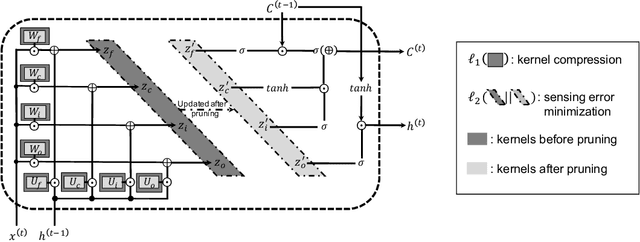
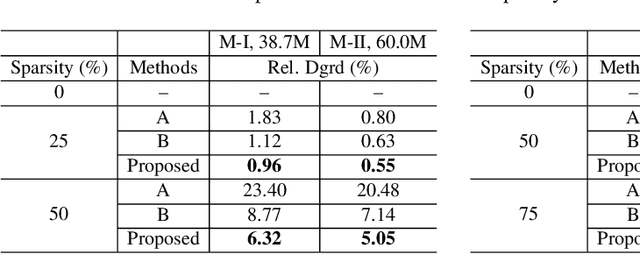
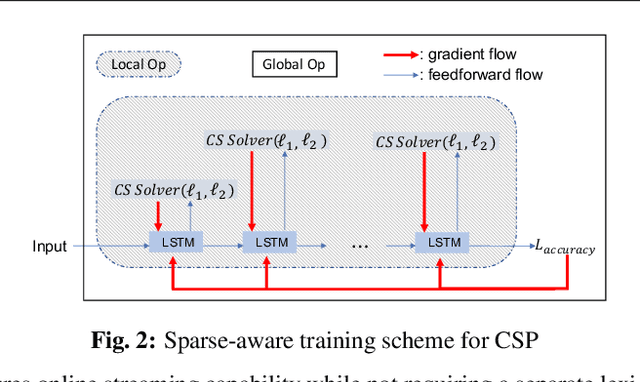
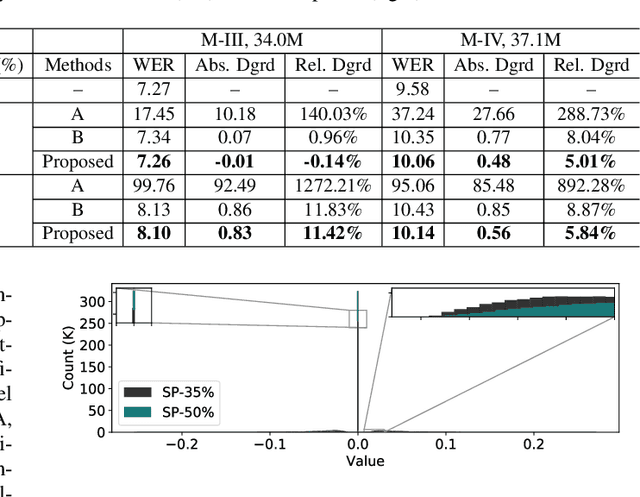
Abstract:In order to achieve high accuracy for machine learning (ML) applications, it is essential to employ models with a large number of parameters. Certain applications, such as Automatic Speech Recognition (ASR), however, require real-time interactions with users, hence compelling the model to have as low latency as possible. Deploying large scale ML applications thus necessitates model quantization and compression, especially when running ML models on resource constrained devices. For example, by forcing some of the model weight values into zero, it is possible to apply zero-weight compression, which reduces both the model size and model reading time from the memory. In the literature, such methods are referred to as sparse pruning. The fundamental questions are when and which weights should be forced to zero, i.e. be pruned. In this work, we propose a compressed sensing based pruning (CSP) approach to effectively address those questions. By reformulating sparse pruning as a sparsity inducing and compression-error reduction dual problem, we introduce the classic compressed sensing process into the ML model training process. Using ASR task as an example, we show that CSP consistently outperforms existing approaches in the literature.
Psychoacoustic Calibration of Loss Functions for Efficient End-to-End Neural Audio Coding
Dec 31, 2020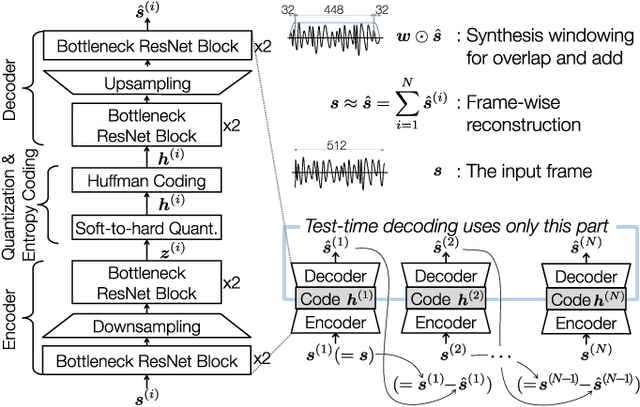
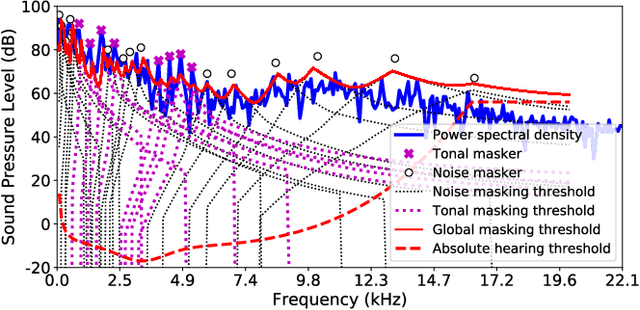
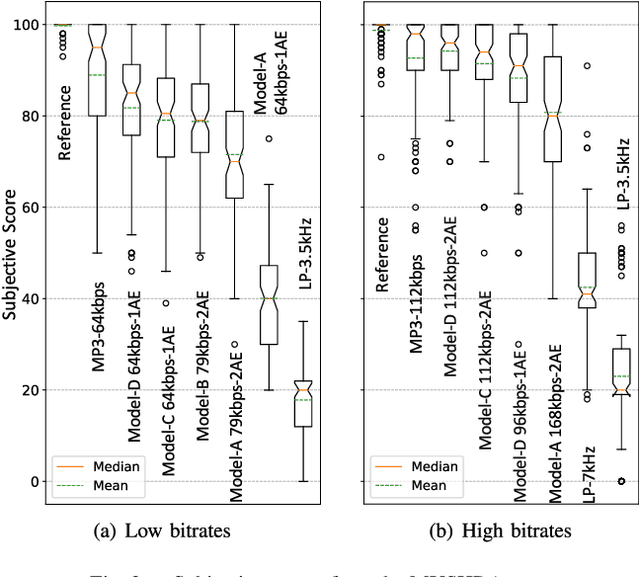
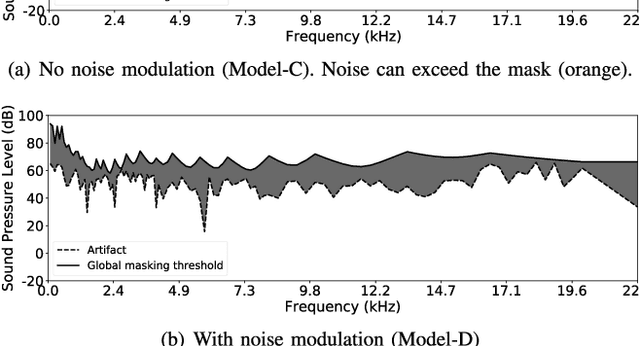
Abstract:Conventional audio coding technologies commonly leverage human perception of sound, or psychoacoustics, to reduce the bitrate while preserving the perceptual quality of the decoded audio signals. For neural audio codecs, however, the objective nature of the loss function usually leads to suboptimal sound quality as well as high run-time complexity due to the large model size. In this work, we present a psychoacoustic calibration scheme to re-define the loss functions of neural audio coding systems so that it can decode signals more perceptually similar to the reference, yet with a much lower model complexity. The proposed loss function incorporates the global masking threshold, allowing the reconstruction error that corresponds to inaudible artifacts. Experimental results show that the proposed model outperforms the baseline neural codec twice as large and consuming 23.4% more bits per second. With the proposed method, a lightweight neural codec, with only 0.9 million parameters, performs near-transparent audio coding comparable with the commercial MPEG-1 Audio Layer III codec at 112 kbps.
 Add to Chrome
Add to Chrome Add to Firefox
Add to Firefox Add to Edge
Add to Edge